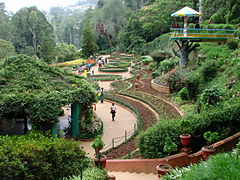Government Botanical Gardens, Ooty
| Government Botanical Garden | |
|---|---|

Government Botanical Garden, Ooty
|
|
| Type | Botanical Garden |
| Location | Ooty (Udhagamandalam) |
| Coordinates | 11°25′08″N 76°42′40″E / 11.418752°N 76.711038°ECoordinates: 11°25′08″N 76°42′40″E / 11.418752°N 76.711038°E |
| Area | 55 acres |
| Opened | 1847 |
| Owned by | Government of Tamil Nadu |
| Operated by | Horticulture Department, Government of Tamil Nadu |
| Status | Open |
| Species | 650 |
| Collections | Cork tree, Paper bark tree, Monkey puzzle tree |
The Government Botanical Garden is a botanical garden in Udhagamandalam, near Coimbatore(Ooty), Tamil Nadu state, India laid out in 1848. The Gardens, divided into several sections, cover an area of around 55 hectares, and lie on the lower slopes of Doddabetta peak. The garden has a terraced layout. It is maintained by the Tamil Nadu Horticulture Department.
It ascends the slopes of the hill at an elevation of 2250–2500 metres above Mean Sea Level. The garden enjoys a temperate climate, with an average rainfall of 140 cm, the most of which is received during south-west monsoon, with frosty nights from November to February. The maximum and minimum temperatures are 28 °C and 0 °C respectively.
The Government Botanical Garden, Udhagamandalm was established in 1848. Its architect was William Graham McIvor. The Marquis of Tweedale prepared the initial layout during the late 1840s. The gardens were established by a subscription of Rs 3 per month amongst the European residents for the purpose of supplying vegetables at a reasonable cost. During the time that Ootacamund was under British control, considerable cultivation of vegetables for the market was carried on by the European settlers and others. Captain Molyneux of the 2nd European Regiment managed the vegetable cultivation. The subscribers received vegetables free of cost. But this arrangement did not work out and in early 1847, a fund was raised by means of donations and subscriptions with a view to forming a horticultural society and a public garden.
There were very few horticulturists at that time. Seeds and saplings were not available locally, but were available in nearby jungles. It was proposed to establish a public garden. For this purpose, a wood was selected between Lushington Hall (the Present Hebron School) and General Sewell’s Property (the present Raj Bhavan). Shortly after the formation of the society, the committee requested state aid for providing a scientific and practical gardener and funds to meet his salary. This suggestion was accepted and Mr.W.G.McIvor from the Royal Botanic Gardens, Kew was sent to Ootacamund by the East India Company. He arrived in March 1848, converted the upper portion, which was a forest, and the lower portion, which was a swamp, into a beautiful garden. He submitted a report at the end of 1848 to the East India Company in London. He took ten years to complete the layout of the Garden.
...
Wikipedia
